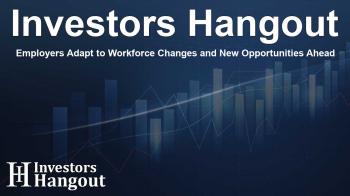Employers Adapt to Workforce Changes and New Opportunities Ahead

Employers' Strategies Amid Workforce Evolution
Recent research highlights how businesses are responding to significant workforce changes. The rapid advancement of technology, especially in artificial intelligence (AI) and robotics, has sparked a transformation in the workplace, prompting many employers to reassess their approach to workforce management and employee benefits.
Embracing Technology with Purpose
According to studies, a notable percentage of companies—72%—are either currently integrating or planning to include robotics and AI in their operations. Along with this, 43% of employers acknowledge that their employees have concerns over the relevance of their skills in an evolving job market. This shift signals an urgent need for businesses to adapt.
Impacts of Advanced Technologies
Employers foresee various implications as advanced technologies like AI take hold. Almost all respondents (92%) recognize the transformative effect on roles within the workforce: 68% anticipate a shift in existing job requirements, 53% expect the emergence of new positions, and 35% predict job redundancies. Catherine Collinson, a prominent voice in workforce studies, emphasizes that while many organizations are keen on integrating technology, strategic plans for workforce development remain a work in progress.
The Dynamics of a Changing Workforce
As the workforce demographic shifts, employers face the reality of an aging population. The proportion of workers aged 55 and older is significant, making it crucial for organizations to be more inclusive of this demographic. In light of labor shortages, there's an untapped potential in hiring older workers, yet less than a third of employers actively consider applicants over 50.
Strategies for Age Inclusion
Organizations need to build an age-friendly workplace. This includes promoting continuous learning opportunities, which helps all employees, regardless of their age, keep skills relevant in a fast-paced environment. Common offerings include mentorship programs, flexible work schedules, remote work options, and assistance for caregivers—resources that showcase an understanding of employee needs across generations.
Enhancing Employee Benefits
In a competitive market for talent, a strong benefits package can set a company apart. Employers increasingly recognize the importance of comprehensive compensation and innovative benefits as essential priorities. Health insurance remains a staple, with 65% of companies providing it, alongside retirement plans like 401(k)s. Interestingly, legislative changes such as the SECURE 2.0 Act are paving the way for more businesses to adopt retirement benefits, thereby helping employees secure a stable financial future.
Building a Supportive Work Environment
Support systems are vital for fostering an engaged workforce. Providing flexible work arrangements and support for caregiving responsibilities can alleviate stress for employees juggling personal and professional responsibilities. Employers that create a culture of support and inclusivity will notice improved morale and productivity.
As Collinson states, employers hold significant power in molding the future workforce by enhancing benefit offerings and encouraging employees to adapt to new market realities. Collaboration between employers and employees is essential in navigating the complexities of this evolving work environment. Investing in people is not just a responsibility; it is a necessity that contributes to the larger economy.
Frequently Asked Questions
What are the key trends affecting the workforce today?
Key trends include the integration of AI and robotics, an aging workforce, and the growing demand for flexible work options.
How can employers support older workers?
Employers can create inclusive hiring policies, offer flexible work arrangements, and promote lifelong learning opportunities.
What should companies consider to enhance their benefits?
Companies should assess employee needs, consider comprehensive health and retirement benefits, and explore new offerings like wellness programs.
How can technology influence workforce productivity?
Technology such as AI can enhance productivity through automation, but it requires ongoing employee training and development to maximize effectiveness.
Why is employee feedback crucial in adapting to changes?
Employee feedback helps employers understand challenges faced in the workplace, allowing for better resource allocation and strategic planning.
About The Author
Contact Dylan Bailey privately here. Or send an email with ATTN: Dylan Bailey as the subject to contact@investorshangout.com.
About Investors Hangout
Investors Hangout is a leading online stock forum for financial discussion and learning, offering a wide range of free tools and resources. It draws in traders of all levels, who exchange market knowledge, investigate trading tactics, and keep an eye on industry developments in real time. Featuring financial articles, stock message boards, quotes, charts, company profiles, and live news updates. Through cooperative learning and a wealth of informational resources, it helps users from novices creating their first portfolios to experts honing their techniques. Join Investors Hangout today: https://investorshangout.com/
The content of this article is based on factual, publicly available information and does not represent legal, financial, or investment advice. Investors Hangout does not offer financial advice, and the author is not a licensed financial advisor. Consult a qualified advisor before making any financial or investment decisions based on this article. This article should not be considered advice to purchase, sell, or hold any securities or other investments. If any of the material provided here is inaccurate, please contact us for corrections.

